The Importance of Ceramic Tile Adhesive A Comprehensive Overview
Ceramic tiles have long been a popular choice for both residential and commercial flooring and wall applications. Known for their durability, aesthetic appeal, and ease of maintenance, ceramic tiles are versatile solutions that fit various styles and needs. However, one crucial aspect that often gets overlooked in the tile installation process is the ceramic tile adhesive. This essential component plays a significant role in ensuring the successful application and longevity of ceramic tile installations.
Understanding Ceramic Tile Adhesive
Ceramic tile adhesive is a bonding agent specifically designed to secure ceramic tiles to various surfaces. It comes in different types, including thin-set mortar, mastic, and epoxy adhesives, each with unique properties suitable for specific applications. Thin-set mortar is the most commonly used adhesive, consisting of a mixture of cement, fine aggregates, and polymers. It provides a strong bond, is suitable for wet areas, and is versatile enough to work with a variety of tile sizes and types.
Mastic, on the other hand, is a pre-mixed adhesive that is easier to work with and is typically used for indoor applications. It is not recommended for high-moisture areas, such as bathrooms and kitchens. Epoxy adhesives are known for their strength and resistance to moisture, making them ideal for commercial applications where durability is paramount.
The Role of Adhesive in Tile Installation
The adhesive acts as a crucial intermediary between the substrate and the tile itself. A well-chosen adhesive ensures that the tiles stay securely in place, preventing movement and potential cracking. Proper adhesion is particularly vital in areas subjected to moisture, temperature fluctuations, and heavy foot traffic.
Moreover, the correct application of the adhesive can aid in achieving a level surface, which is essential for the overall appearance and functionality of the tile installation. A level surface reduces the risk of tile lippage, where adjoining tiles are not flush with one another, leading to an unattractive finish and potential trip hazards.
Factors to Consider When Selecting Tile Adhesive
ceramic tile adhesive

When choosing a ceramic tile adhesive, several factors must be taken into account to ensure a successful installation
1. Tile Material Different tiles may require different types of adhesives based on their composition. Porcelain tiles, for example, need an adhesive with a higher bonding strength due to their low porosity.
2. Substrate Type The surface where tiles will be installed (e.g., concrete, plywood, drywall) affects the choice of adhesive. For instance, a cement board substrate might require a thin-set mortar, while a wall might be suitable for mastic.
3. Moisture Exposure Areas with high moisture levels, such as bathrooms and kitchens, usually require water-resistant adhesives to prevent deterioration over time.
4. Tile Size and Weight Larger and heavier tiles demand adhesives with higher shear strength to support their weight without sagging or slipping.
5. Environmental Conditions Factors such as temperature and humidity during installation can influence the adhesion process. It's essential to select an adhesive that can withstand the specific conditions of the installation site.
Conclusion
In summary, ceramic tile adhesive is a fundamental element of any tile installation project. By understanding the different types of adhesives available and the factors influencing their selection, homeowners and contractors can make informed decisions that lead to successful and lasting ceramic tile applications. Investing time and effort into choosing the right adhesive not only enhances the aesthetic appeal of the space but also ensures the structural integrity of the installation over time. With the right adhesive, ceramic tiles can provide beauty and functionality for many years to come, reaffirming their place as a favored choice in both residential and commercial settings.
-
Rdp Powder: Key Considerations for Wholesalers in the Building Materials IndustryNewsJul.08,2025
-
Key Considerations for Wholesalers: Navigating the World of Hpmc - Based ProductsNewsJul.08,2025
-
Hpmc Detergent: Key Considerations for WholesalersNewsJul.08,2025
-
Key Considerations for Wholesalers: China Hpmc For Tile Adhesive, Coating Additives, Concrete Additives, and MoreNewsJul.08,2025
-
Crucial Considerations for Wholesalers: Navigating the World of Construction MaterialsNewsJul.08,2025
-
Key Considerations for Wholesalers Sourcing Additive For Cement, Additive For Concrete, Additive For Putty from Additive Manufacturer Shijiazhuang Gaocheng District Yongfeng Cellulose Co., Ltd.NewsJul.08,2025




